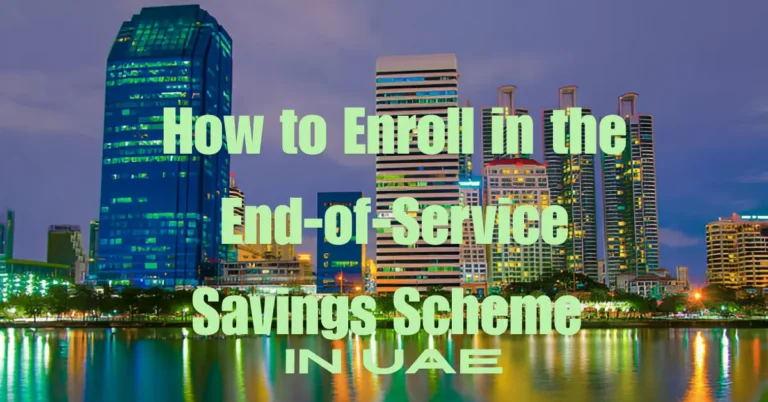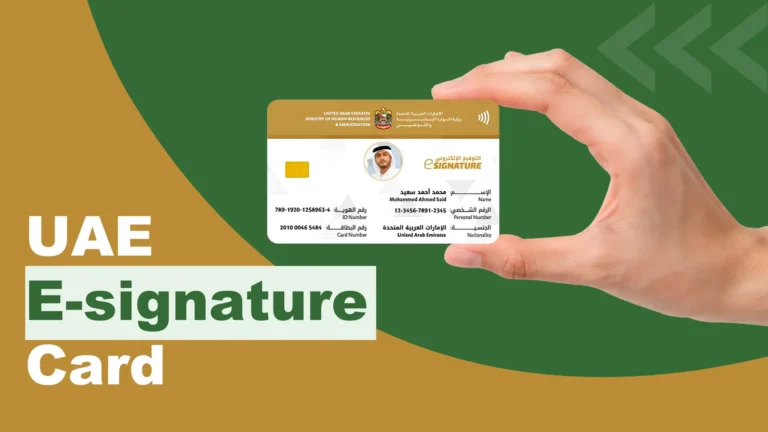Saving Scheme an Alternative of End-of-Service Benefits System in the UAE

Introduction
The United Arab Emirates (UAE) has introduced an Alternative End-of-Service Benefits System, commonly known as the “Savings Scheme,” as a modern alternative to the traditional end-of-service gratuity. This voluntary program, launched by the Ministry of Human Resources and Emiratisation (MOHRE), allows employers to invest employees’ end-of-service benefits in approved funds, yielding returns by the time employment ends. The initiative aligns with UAE labor laws and aims to enhance financial security for employees while maintaining compliance with UAE Labour Law provisions.
In this article, we provide a comprehensive overview of the Savings Scheme, its legal basis, how it works, benefits for UAE expatriates and nationals, and guidance on enrollment, along with answers to frequently asked questions. This information serves as a vital awareness guide for UAE employees seeking to understand their end-of-service benefit options.
Who Can Join the Savings Scheme?
As of 2025, this end-of-service alternative is available to:
- Private sector employees across the UAE.
- Free zone workers, including those under the DIFC and ADGM.
- Government employees in federal entities, depending on approvals.
- Expats and UAE nationals alike.
Participation is voluntary, and employers can opt in to benefit from streamlined HR practices and enhanced employee retention
Understanding Traditional End-of-Service Gratuity in the UAE
Under the current UAE Labour Law (Federal Decree Law No. 33 of 2021 and its amendments), most employees are entitled to an end-of-service gratuity payment when leaving a job after at least one year of service. This gratuity is a lump sum calculated based on the employee’s basic salary and years of service. Key points of the traditional gratuity system include:
- Eligibility: Employees qualify after one year of continuous service (no gratuity if service is less than 1 year).
- Calculation: For service between 1 and 5 years, gratuity is 21 days’ basic pay per year. For service beyond 5 years, it is 30 days’ basic pay for each additional year. The calculation uses the final basic salary at the time of termination, which can significantly increase the payout for long-serving employees.
- Legal Protection: Gratuity is a legal right under UAE law and must be paid within 14 days of the end of employment. However, it remains an unfunded liability on the employer’s books until the employee leaves.
While the traditional gratuity provides an end-of-service cushion, there have been concerns about inflation eroding value over time and the risk of employers being unable to pay in cases of business distress or bankruptcy. These challenges set the stage for a more secure, investment-based solution – the new Savings Scheme – which is designed to complement and modernize end-of-service benefits in the UAE.
What is the Alternative End-of-Service Benefits “Savings Scheme”?
The Savings Scheme is a voluntary, government-approved program introduced via Cabinet Resolution No. 96 of 2023 to overhaul how end-of-service benefits are handled. Instead of the employer accruing a lump-sum gratuity to pay at the end, participating employers make monthly contributions to regulated investment funds on behalf of their employees.
These contributions (and any investment profits earned) will be paid out to the employee when their service ends, effectively replacing the traditional gratuity payout. For employers and employees interested in joining, understanding how to enroll in the End-of-Service Savings Scheme is essential. Key characteristics of the Savings Scheme include:
- Voluntary Enrollment by Employers: Companies in the UAE private sector (including most free zones) can choose to opt into the Savings Scheme; it is optional for employers and not mandated by law. Once an employer joins, certain or all employees are enrolled, and the standard gratuity system is suspended for those employees. (Notably, employers in DIFC or ADGM free zones are exempt, as those jurisdictions have their own schemes).
- Regulated Investment Funds: Employer contributions are invested in well-proven funds licensed by the UAE Securities and Commodities Authority (SCA). MOHRE has approved multiple fund providers (e.g. Daman Investments, National Bonds, First Abu Dhabi Bank, Lunate), ensuring choices that include Sharia-compliant funds, capital-guaranteed portfolios, and other diversified options. This allows employees to potentially earn investment returns on their end-of-service money, which is a new benefit of the scheme.
- Legal Equivalence to Gratuity: The amounts accumulated in the Savings Scheme (the employer’s contributions plus returns) are legally considered to be the employee’s end-of-service compensation, fulfilling the employer’s obligations under the labour law. Importantly, any gratuity accrued before joining the scheme remains owed by the employer for that prior period and must be preserved and paid out as per law when the employee leaves.
In essence, the Savings Scheme transforms end-of-service benefits into a managed savings and investment plan. It aims to deliver the same or greater value to employees while providing more security. MOHRE’s Awareness and Guidance campaigns have been actively informing employees and employers about this new system as part of its media center initiatives.
How Does the Savings Scheme Work?
Enrollment and Contributions: For an employer to join the Savings Scheme, they must submit a request to MOHRE and sign up with one of the accredited investment funds. The employer can choose which employees or categories of staff to include (for example, they might start with certain grades or departments). Once approved and enrolled:
- Monthly Contributions by Employer: The employer makes a monthly basic subscription contribution to the chosen fund for each enrolled employee. The contribution rate mirrors the gratuity accrual rate under the law; 5.83% of the employee’s monthly basic salary for those with <5 years’ service, and 8.33% for those with >5 years. (These percentages correspond to 21 days and 30 days of basic pay per year, respectively, which is why they align with the existing gratuity formula.) Employers must deposit these amounts into the fund within 15 days of the end of each month. Crucially, these contributions are paid by the employer and are not deducted from the employee’s salary.
- Investment Options: The contributed amounts are invested as per the employee’s chosen investment portfolio (or default option). Skilled workers have the freedom to choose from various investment options offered by the fund (e.g. balanced funds, growth funds, Sharia-compliant funds), according to their risk preference. Unskilled workers are automatically placed in a Capital Guarantee Portfolio, which is a low-risk option ensuring their capital is preserved. This two-tier approach ensures that every employee, regardless of skill level, has an appropriate investment strategy – either risk-protected or with growth potential.
- Additional Voluntary Savings (Optional): Employees enrolled in the scheme can voluntarily contribute extra savings to their fund if they wish. They may instruct their employer to deduct a portion of their salary (or contribute a lump sum) into the fund, up to a maximum of 25% of their annual wage. These voluntary contributions are separate from the core end-of-service benefit – they are essentially a personal savings feature. Employees can withdraw their voluntary contribution amounts (and any earnings on them) at any time, even before leaving the company, as per fund rules. Notably, such voluntary savings are not counted as part of the end-of-service benefit payout – they are an extra benefit the employee controls.
- Vesting and Entitlements: Upon termination of employment, the employee is entitled to receive the full amount of the employer’s contributions made on their behalf, plus any investment returns earned, in one lump sum. The scheme regulations mandate that this payout be made within 14 days after the employee’s last working day, similar to the requirement for gratuity. Employees also have the choice to keep their funds invested instead of withdrawing upon leaving; for example, an employee changing jobs could leave the savings in the fund to continue growing, and even have a new employer contribute to the same fund if agreed. In the unfortunate event of an employee’s death, the accumulated savings are paid to their beneficiaries within 10 working days.
- Portability between Jobs: If an employee switches jobs within the UAE, they have options regarding their accumulated savings. They may withdraw the amount when leaving the first employer, or transfer/retain it in the fund to continue investing. A new employer who also participates in the scheme can even take over contributions to that same fund (after signing a contract with the fund provider), or enroll the employee in a different approved fund. This flexibility means the Savings Scheme can function somewhat like a portable retirement account for employees across their career in the UAE.
It’s important to note that while the scheme introduces monthly funding of end-of-service benefits, the underlying benefit calculation remains similar to the standard gratuity (5.83% ≈ 21 days/year, 8.33% ≈ 30 days/year). One key difference is the timing of contributions and potential growth of the fund. Also, normal gratuity eligibility rules apply; for instance, if an employee leaves before completing one year of service, they are not entitled to keep the employer’s contributions (in fact, the employer can recover contributions if employment terminates in under a year). This ensures the scheme aligns with existing labor regulations regarding minimum service periods.
Gratuity vs. Savings Scheme Comparison
| Aspect | Traditional Gratuity | Alternative Savings Scheme |
| Timing of Payment | At the end of service | Monthly contributions throughout employment |
| Investment Opportunity | None | Yes – Managed by professional firms |
| Flexibility | Fixed calculation | Customizable risk levels for investments |
| Risk of Loss | Risk if company goes bankrupt | Secure in an independent trust account |
| Portability | No | Yes – Fund stays with employee, even if job changes |
Benefits of the Savings Scheme for Employees and Employers
The move towards a savings-based end-of-service system brings several advantages for both employees and employers in the UAE:
- Financial Security for Employees: The Savings Scheme guarantees that employees’ end-of-service benefits are safeguarded and invested independently of the employer’s financial situation. Workers no longer need to worry about losing their gratuity if an employer faces insolvency or cash-flow problems. The scheme’s design explicitly aims to protect employees from inflation, company default or bankruptcy by having their funds held in regulated investments. This provides peace of mind that the money will be there at the end of employment no matter what.
- Potential for Growth: Unlike the traditional gratuity, which is a fixed sum, the Savings Scheme gives employees the opportunity to earn returns on their end-of-service funds. By investing in reputable funds, employees could end up with a larger amount than the statutory minimum gratuity, thanks to compounded investment income. Even conservative portfolios (like capital-guaranteed ones) may yield modest growth that at least protects against inflation erosion. In short, the value of end-of-service benefits can keep up with or beat the cost of living over time.
- Encouraging a Savings Culture: The scheme’s allowance for voluntary contributions encourages employees to save a portion of their salary towards long-term goals. This is particularly beneficial for expatriate employees (who don’t have pension schemes in the UAE) as it acts as a savings plan for expatriates in addition to the mandated benefit. Employees can build a nest egg by contributing up to 25% of their salary to the fund, with the flexibility to withdraw these extra savings if needed. This cultivates better financial planning habits among the workforce.
- On-Time, Transparent Payouts: With the funds being managed by third-party fund managers under government oversight, the disbursement of end-of-service benefits becomes more streamlined and timely. Regulations require that payouts happen within two weeks of termination, and since the money is already set aside in a fund, delays are less likely. This contrasts with the traditional scenario where an employer might delay gratuity payment due to cash constraints.
- Benefits to Employers (Talent Attraction and Cost Management): Employers in the Savings Scheme can position themselves as forward-thinking and employee-focused. According to MOHRE, such companies are viewed as “outstanding places to work” that value financial well-being, boosting loyalty and attracting top talent. The scheme can also improve productivity by giving employees greater financial security. From a cost angle, monthly contributions based on current basic salaries may be more economical than traditional gratuity, which is calculated on the higher final salary. It also shifts future liabilities off the company’s balance sheet, aiding long-term financial planning.
- Labor Market Flexibility and Competitiveness: On a macro level, the government views the Savings Scheme as a way to enhance the attractiveness and flexibility of the UAE labor market. It modernizes end-of-service benefits in line with global best practices (many countries use provident funds or pension schemes). This can make the UAE more appealing to skilled expatriates who value retirement-like benefits. For employers, offering an invested savings plan can be a competitive differentiator in compensation packages.
Summary
The UAE’s Savings Scheme, introduced under Cabinet Resolution 96 of 2023, allows employers to make monthly contributions to regulated investment funds instead of paying a lump-sum gratuity. These funds grow with profits and are paid to the employee at the end of service. It’s a modern, secure alternative to traditional end-of-service benefits.
Managed by MOHRE and Securities and Commodities Authority (SCA), the scheme offers better financial planning for employers and peace of mind for employees. It’s voluntary but strongly promoted as a best practice. Employees should stay informed and learn how to enroll in the EoS Savings Scheme through official channels.





